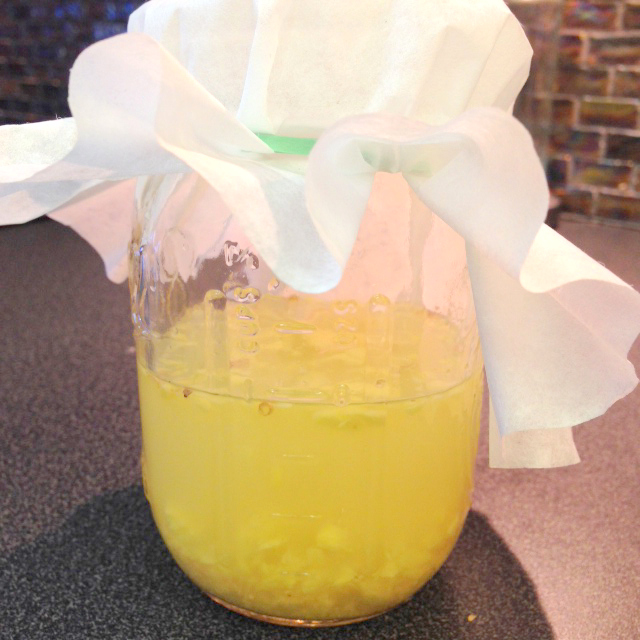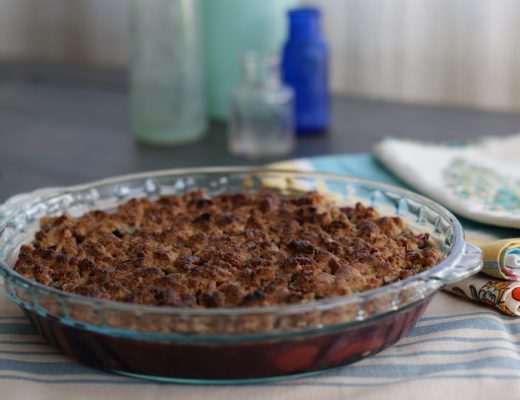This post makes us squeal with delight! Stacy LOVE LOVE LOVES ginger, perhaps more than chocolate (maybe). It was not too long ago that we reviewed Jill’s book Fermented, with the help of friends for a fermentation party, and discovered that making our own fermented products is not so scary after all. Fermented is a delightful resource that really changed the way we look at the fermentation process. It’s no longer a scary, daunting process that we are certain will lead us down the path of food borne illness, but rather a fun and exciting activity that we can add to our kitchen repertoire. Thanks to the stunning and simple, clean photography of Bill Staley, the recipes are beautifully illustrated too. It’s the kind of book that you can’t help but flip through and earmark the pages you must try. We’ve been so lucky to be able to become friends with Jill through our network of Paleo blogger friends, and we are so glad to be able to have her as apart of the paleo community. We are so happy that Jill has come on the blog today to share her recipe for Probiotic Ginger Ale, because we really can’t get enough gingery, gut healing drinks in our house!
Us together with Jill at a joint book signing last October at Salt & Pepper Books, also with Diana Rodgers, Hayley Mason Staley and Bill Staley. Photo courtesy of Primal Palate.
♥♥♥
Hi! I am so happy to be writing this post for the Paleo Parents and I’m really grateful to Matt and Stacy for having me on their site.
If you’ve read my book, Fermented, (and I truly hope you have!) then you know how strongly I feel about incorporating fresh, healthy, probiotic foods into your daily diet. It’s an essential part of any eating paradigm whether you consider yourself to be a strict Paleo devotee or are just casually trying to incorporate more clean eats onto your weekly menus. For omnivores and vegans alike, fermented foods can help us all.
My initial foray into fermenting food started with making my own kombucha and blossomed from there to all kinds of vegetable, fruit, and even meat ferments. While I love experimenting with many types of fermentation, my interest still favors kombucha. I’ve written extensively about kombucha making on my own site, First Comes Health, and of course it’s covered in Fermented. The reason I love making it and experimenting with different flavorings is because the final product has wide appeal. Many people who are new to fermented foods enjoy it because it’s similar to pop, is often sweet, can be personalized and flavored in countless ways, and doesn’t have as much of that characteristic, pungent “ferment-y” taste to it that some people do not find appealing in fermented vegetables.
Of course, kombucha isn’t the only game in town. Water kefir is another popular substitution for soda that is easy to make and can be flavored in all kinds of ways. The drawback to both kombucha and water kefir is that they require starters (water kefir grains or a kombucha SCOBY) that many may not find easily accessible.
Because of this I’ve been experimenting with a whole new world of fermented beverages that the casual home fermenter – or even someone who is new to fermentation – can try with minimal effort, equipment, materials, and financial investment.
To begin, you will need a bacteria-rich starter. This will be the fermenting foundation to all kinds of fermented beverages. If you are already familiar with kombucha or water kefir making, then you can liken this easy-to-make bacterial starter to a SCOBY or water kefir grains. It will give your fermented beverages the bacterial boost it needs to properly ferment and provide the final product with a very pleasant fizz.
So, without further ado, let’s make this bacterial starter! It’s called a ginger bug, which is probably the cutest name in all of fermentation, no?
For the Ginger Bug, you will need these things for equipment:
- A clean glass jar (2 pints is plenty big)
- Cutting board and knife
- A fine grater or microplane
- Coffee filter or fine cloth with a rubber band to secure it on the jar
Ingredients
- A medium-sized hand of ginger
- Filtered water (room temperature)
- Sugar of your choice (cane sugar, Sucanat, or plain old white sugar all work well)
- Time
Instructions
- Peel a thumb-sized knob of ginger. Finely chop or pulverize using the fine grater until you have about two tablespoons. Add to jar.
- Add ¼ cup of filtered water to the jar.
- Add two tablespoons of sugar to the jar.
- Stir well until the sugar is dissolved.
- Cover with the coffee filter or cloth and set on your countertop.
- Each day, add a little bit more ginger (about a tablespoon), more water (a few tablespoons), and more sugar (about a teaspoon).
Notes
Making a ginger bug isn’t difficult at all, but takes some time and daily attention. Once you have assembled all of your ingredients and equipment, it takes but a few minutes to get it going. Note that I didn’t give exact measurements for the ingredients and that’s because making a ginger bug isn’t an exact science.
After three or four days you will notice that your ginger bug is bubbly and foamy. You may even see it fizz and effervesce a little bit. This is good! Bacteria at work!
Where did that bacteria come from? It came from the air in your home, from the jar you used, the ginger, the sugar, the water, your hands, and anything else that may have come in contact with your ginger bug. This is wild fermentation. You didn’t start with a culture of bacteria to make a ginger bug, you used what is found in the wild to create a bacterial starter.
When you have a foamy, fizzy, bubbling ginger bug, it’s time to put it good use!
If you’re following me on Instagram these days, you may have seen me preparing a few worts. What’s a wort, you say? A wort is the flavoring portion of fermented beverages. It’s what you combine with your bacterial starter (your bug) to make a fizzy, probiotic drink. Get creative with wort making! Use your imagination to make all kinds of unique flavors. The most basic and easiest is ginger ale.
For the Ginger Ale Wort, you will need:
- Large pot
- Cutting board and knife
Ingredients
- A medium-sized hand of ginger
- Filtered water (about three quarts)
- Sugar of your choice (a cup is plenty) **
- The juice of one lemon
Instructions
- Bring the water to a gentle boil
- Peel and roughly chop the ginger until you have a cup.
- Add ginger and lemon juice to the boiling water, reduce to a simmer, and allow to cook for 30 minutes.
- Remove from the heat, add the sugar, and stir to dissolve.
- Allow the wort to come to room temperature.
Notes
**I use organic cane sugar or organic white sugar only in my ferments. The simpler the sugar, the better because it is fuel for the bacteria and not for flavoring. I tell people to use the sugar that they want to use (coconut, date, etc.) but flavor will be changed. I don't like the taste of molasses or unrefined sugar, but be aware that you may not get good fermentation results. DO NOT use honey, stevia, maple syrup, molasses, etc. They just don't yield good results, especially the honey which is antibacterial.
Now it’s time to bring the bug and the wort together!
To make the Probiotic Ginger Ale, you will need:
- A large glass jar (gallon sized)
- Coffee filter or fine cloth with a rubber band to secure it on the jar
- Fine strainer
- Funnel
- Flip-top bottles
Ingredients
- A ginger bug (bubbly and alive!)
- Ginger ale wort
Instructions
- Strain the ginger bug, reserving all the water.
- Strain the pieces of ginger out of the wort.
- Combine the ginger bug water with the room-temperature wort in a gallon sized glass jar. Cover.
- Allow to sit at room temperature to ferment for several days. Shorter fermentation yields a sweeter ginger ale, longer fermentation yields a drier ginger ale. The choice is yours. Taste test to decide what you prefer.
- After the ginger ale has fermented to your liking, use a funnel to pour the ginger ale into flip-top bottles, seal, and sit overnight at room temperature.
- Refrigerate and enjoy!
Notes
Like any fermentation project, making probiotic beverages isn’t difficult, but does take time and attention. The results are very much worth it! You’ll soon have a fridge filled with fizzy fermented drinks that your whole family can enjoy.
Connect with Jill:
Blog
[author] [author_image timthumb=’on’]http://paleoparents.com/wp-content/uploads/2014/03/Jill.jpg[/author_image] [author_info]Jill Ciciarelli is a food lover, kitchen adventurer, board-certified holistic-health coach, and keeper of the blog First Comes Health. With a bachelor’s degree in psychology from The Pennsylvania State University, a bachelor’s degree in Italian language and literature from the University of Pittsburgh, and certification from the Institute for Integrative Nutrition in holistic health, Jill has channeled her various passions into instilling a desire for long-term health in her clients. She has helped them reach their health and wellness goals by advocating an ancestral way of eating and serves her community as the Weston A. Price Foundation chapter co-leader. You can find her fermenting and experimenting in her urban high-rise kitchen and follow along with her on her website, Facebook, Instagram, and Twitter. Jill lives in Pittsburgh, Pennsylvania, with her husband, Brian (aka Dude), and Quincy, the sweetest kitty in the world.[/author_info] [/author]










